
The flowering plant genus Ipheion belongs to Allioideae, a subfamily of the family Amaryllidaceae. The World Checklist of Selected Plant Families no longer recognize the genus, regarding it as a synonym of Tristagma, although The Plant List accepts two species.

Nothoscordum is a genus of New World plants in the onion tribe within the Amaryllis family. It is probably paraphyletic. The genus is native to North, Central and South America, though a few species have become naturalized in various parts of the Old World.
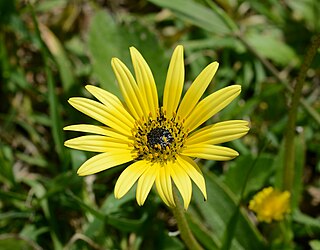
Arctotis is a genus of annual and perennial plants in the family Asteraceae.

Myosotis is a genus of flowering plants in the family Boraginaceae. The name comes from the Ancient Greek μυοσωτίς "mouse's ear", which the foliage is thought to resemble. In the Northern Hemisphere, they are colloquially known as forget-me-nots or scorpion grasses. Myosotis alpestris is the official flower of Alaska and Dalsland, Sweden. Plants of the genus are commonly confused with Chatham Islands' forget-me-nots, which belong to the related genus Myosotidium.

Coprosma is a genus of flowering plants in the family Rubiaceae. It is found in New Zealand, Hawaiian Islands, Borneo, Java, New Guinea, islands of the Pacific Ocean to Australia and the Juan Fernández Islands.

The Gnaphalieae are a tribe of flowering plants in the family Asteraceae. It is most closely related to the tribes Anthemideae, Astereae, and Calenduleae.

Gnaphalium is a genus of flowering plants in the family Asteraceae, commonly called cudweeds. They are widespread and common in temperate regions, although some are found on tropical mountains or in the subtropical regions of the world.

Abrotanella is a genus in the family Asteraceae, of 23 species, native to Australia, New Zealand and southern South America.

Olearia, most commonly known as daisy-bush, is a genus of flowering plants belonging to the family Asteraceae, the largest of the flowering plant families in the world. Olearia are found in Australia, New Guinea and New Zealand. The genus includes herbaceous plants, shrubs and small trees. The latter are unusual among the Asteraceae and are called tree daisies in New Zealand. All bear the familiar daisy-like composite flowerheads in white, pink, mauve or purple.

Celmisia is a genus of perennial herbs or subshrubs, in the family Asteraceae. Most of the species are endemic to New Zealand; several others are endemic to Australia.
The New Zealand Threat Classification System is used by the Department of Conservation to assess conservation priorities of species in New Zealand.
Gustave Beauverd (1867–1942) was a Swiss botanist, specializing in Pteridophytes, Bryophytes, and Spermatophytes.
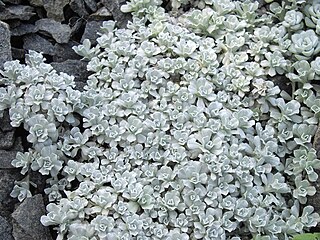
Ewartia is a genus of flowering plants in the family Asteraceae native to New Zealand and Australia. It is named after a 20th-century botanist and plant collector named Alfred James Ewart.
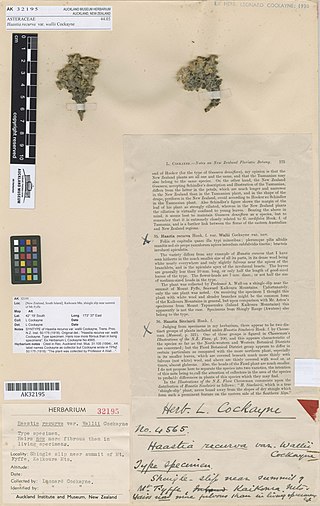
Haastia is a genus of flowering plants in the daisy family, Asteraceae, native to New Zealand.
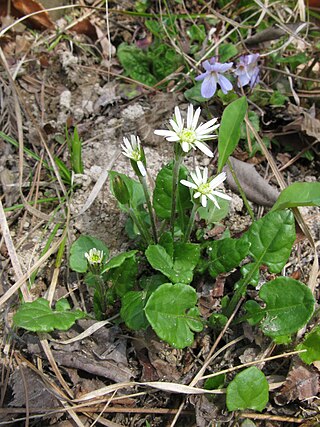
Leibnitzia (sunbonnets) is a genus of Asian and North American flowering plants in the family Asteraceae.
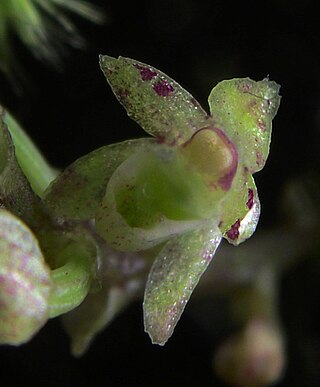
Drymoanthus, commonly known as midget orchids is a genus of epiphytic orchids in the family Orchidaceae. Plants in this genus are relatively small and unbranched with thick roots, narrow crowded leaves and small scented green flowers with a white labellum. There are four species, found in Australia, New Zealand and New Caledonia.

Pachystegia is a genus of shrubs in the family Asteraceae, known as Marlborough rock daisies, with distinctive leathery leaves and daisy-like flowers. They are naturally found only in dry areas of the north-eastern South Island of New Zealand.
Kovalevskiella is a genus of Asian plants in the dandelion tribe within the sunflower family.

Brian Peter John Molloy was a New Zealand plant ecologist, conservationist, and rugby union player.

Leptinella filiformis, or slender button daisy, is a species of flowering plant in the daisy family, found only in the north-eastern part of the South Island of New Zealand. Thought to be extinct by the 1980s, it was rediscovered growing on a Hanmer Springs hotel lawn in 1998, and in the wild in 2015.

















